

How to Train for Your First Ultra Marathon. People already think you're crazy for running marathons, and now you tell them you want to run an ultra.

An ultra marathon is defined as anything longer than a marathon, although many ultra runners would argue the distance starts at 50K and that timed events don't count. A successful first ultra is one where you: 1. Finish. 2. Don't get hurt. 3. Here is how you can accomplish that: 1. 2. Low-Carbohydrate Diets for Athletes. Heart Rate Formulas for Triathletes - D3 Multisport. It seems that there are many ways to determine your training zones from a wide variety of methods.
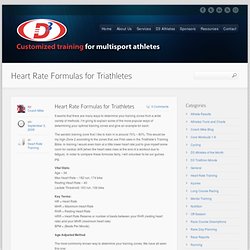
I’m going to explain some of the more popular ways of determining your optimal training zones and give an example for each. The aerobic training zone that I like to train in is around 70% – 80%. This would be my high-Zone 2 according to the zones that Joe Friel uses in the Triathlete’s Training Bible. In training I would even train at a little lower heart rate just to give myself some room for cardiac drift (when the heart rates rises at the end of a workout due to fatigue). In order to compare these formulas fairly, I will volunteer to be our guinea pig. Vital Stats: Age – 34 Max Heart Rate – 182 run, 174 bike Resting Heart Rate – 40 Lactate Threshold: 163 run, 156 bike. The Daily Blog of Helga van Niekerk. The Daily Blog of Helga van Niekerk Child of God, Wife, Mom, Daughter-in-law, Friend – On a LCHF journey since October 2012… oh and also Radio Presenter for the Rise and Shine Show on 107.5 CCFm :) Skip to content Professor Tim Noakes Talks We have been blessed on the Rise and Shine show to have South Africa’s leading LCHF expert Professor Tim Noakes for an hour Prof Tim Noakes outside CCFm.

The Ultimate Ultramarathon Training Plan. DO.
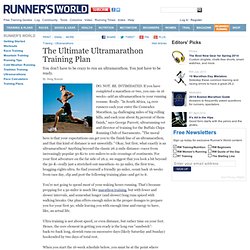
NOT. BE. INTIMIDATED. High-fat, low-carb diets: how to try one for yourself. In the first part of this two-part series, Joe McQuillan and Alan McCubbin introduced us to high-fat, low-carbohydrate (HFLC) diets and compared two athletes who were about to start a HFLC diet.

In the second and final part in this series our authors show how the two athletes responded to their diets and show you what a HFLC diet actually looks like. If you haven’t already, we recommend you read part 1 of this series before reading on. Follow-up lab results In the first part in this series we presented results from Joe’s lab, showing two athletes’ responses to a incremental step test in which they cycled with an increasing power output. We measured the percentage of energy the athletes got from carbohydrates and the percentage they got from fat. We repeated the tests 10-15 weeks later — after the athletes had completed their HFLC diets — and compared the two tests, showing just how differently the two athletes responded.
Part 2: Determining Your Heart Rate Zones « Two Rivers Treads Two Rivers Treads. So how do you determine what this “go no higher” HR is to maximize aerobic development and all the cellular and vascular changes that occur.
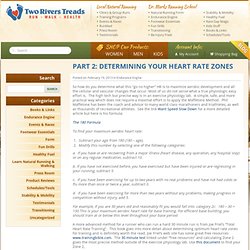
Most of us do not sense what a true physiologic easy effort is. The high tech but precise way is in an exercise physiology lab. A simple, safe, and more practical way which does not require a maximal effort is to apply the Maffetone Method. Phil Maffetone has been the coach and advisor to many world class marathoners and triathletes, as well as thousands of recreational athletes. See the link Want Speed Slow Down for a more detailed article but here is his formula: The 180 Formula. Part 1: Slow Down to Build the Endurace Engine « Two Rivers Treads Two Rivers Treads. “Train Don’t Strain” Arthur Lydiard 1960 A natural runner is progressively improving their running economy.
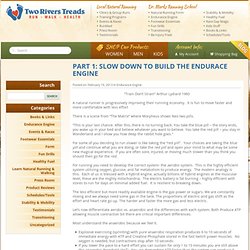
It is fun to move faster and more comfortable with less effort There is a scene from “The Matrix” where Morpheus shows Neo two pills. “This is your last chance. After this, there is no turning back. For some of you deciding to run slower is like taking the “red pill”. For running you need to develop the correct system- the aerobic system. The 50-Mile Ultramarathon Training Plan. 10 Tips for UltraMarathon Training > RunningFreeOnline. 1.
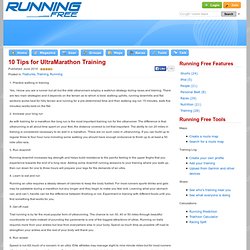
Practice walking in training Yes, I know you are a runner but all but the elite ultrarunners employ a walk/run strategy during races and training. There are two main strategies and it depends on the terrain as to which is best; walking uphills, running downhills and flat sections works best for hilly terrain and running for a pre-determined time and then walking (eg run 15 minutes, walk five minutes) works best on the flat. 2. Increase your long run As with training for a marathon the long run is the most important training run for the ultrarunner. 3. Running downhill increases leg strength and helps build resistance to the painful feeling in the upper thighs that you experience towards the end of a long race. 4.
Running an ultra requires a steady stream of calories to keep the body fuelled. Fitness Intuition: How to Run Your First 50-Miler. See also: Art of the Low-Mileage Ultra.

From Eric Robinson, a wise young man who runs 2-4 ultras per month. This long ramble aims at helping first-timers finish a 50-mile race, though seasoned ultrarunners may find something worthwhile here as well, since most of what's said has been gleaned from ultrarunners with a lot more miles in their legs than I have. The Prime Directive. Never do anything in a race that you haven't tried first in training. This applies to food, drink, shoes, belt packs, run/walk strategy, and mental attitude. ULTRAmarathon Training - How to Train for an Ultramarathon. Metabolic Efficiency: Becoming A “Better-Butter-Burner” For those of you who are totally lean, terrific fat burners and never have any GI issues, stop reading this article.

But for those of you who want to become, in the words of former fitness expert Covert Bailey, a “better-butter-burner,” read on. This is not new science, but could be considered reemerging science. The Crossover Theory has been around since the 1930s and in the 1970s and 1980s, there was a large amount of research on aerobic training in relation to fat burning. High mileage weeks and long, slow, distance training was the norm. It wasn’t until later that quality became the standard in training over quantity. Metabolic Crossover So, what’s wrong with carbohydrates? Signs that your plan may not be working can be anything from GI distress (bloating, cramping, vomiting) to poor recovery and fatigue to out-and-out bonking. “Efficiency” is usually thought of as doing something well with the least amount of effort. 10 Tips for UltraMarathon Training > RunningFreeOnline.